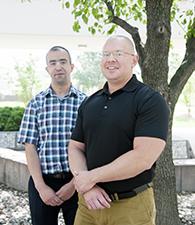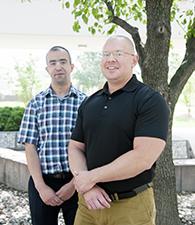
Credit: Kansas State University
MANHATTAN, Kan. — By understanding the functional differences between proteins expressed by two E. coli strains, researchers at Kansas State University are exploring new opportunities to inhibit their impacts to human health.
The scientists are using findings from their study, "NleB/SseK effectors from Citrobacter rodentium, Escherichia coli, and Salmonella enterica display distinct differences in host substrate specificity," published in the Journal of Biological Chemistry, to start researching new ways to treat two types of E. coli: enterohemorrhagic E. coli and enteropathogenic E. coli.
Enterohemorrhagic E. coli outbreaks are traced to improperly cooked meats, unpasteurized dairy products and unwashed vegetables. Enteropathogenic E. coli is a common cause of diarrhea in developing countries, especially in children younger than 2, according to Philip Hardwidge, professor of diagnostic medicine and pathobiology in the College of Veterinary Medicine.
Both forms cause abdominal pain and severe diarrhea, and in some cases, enterohemorrhagic E. coli infections progress to hemolytic uremic syndrome, which is a potentially fatal kidney illness, especially for children.
Hardwidge and postdoctoral researcher Samir El Qaidi suggest that strategies to inhibit the activity of NleB, a protein expressed by both forms of E. coli, may be effective in reducing E. coli's virulence, or its ability to cause disease in people. Thus, their work could lead to new antivirulence treatments, which are important alternatives to antibiotics that are less prone to antibacterial resistance, Hardwidge said.
This method of combating E. coli would not kill the bacteria because the bacteria do not need this protein to replicate. Rather, it would inhibit the bacteria's ability to cause disease in the body.
The Kansas State University scientists are working with researchers at the University of Kansas to screen for inhibitors of the NleB protein that could potentially be developed for antivirulence treatment of E. coli and other bacteria that have the protein, including salmonella.
"If we could block this protein from functioning, we might reduce bacterial burdens and let the immune system have a chance to do its job in clearing the infection," Hardwidge said. "Pathogen-specific therapies are expected to be less disruptive to the safe, normal bacteria in the intestine, many of which perform beneficial functions for humans. This strategy also could be used to supplement existing therapies to increase their effectiveness in treating infections."
Additionally, their study resolves an important debate regarding proteins found in enterohemorrhagic E. coli and enteropathogenic E. coli.
NleB appears to have a nearly identical genetic sequence in both forms of the E. coli, Hardwidge said. Scientists had thought NleB performed similar functions in each type of E. coli, but previous studies from other institutions came to different conclusions about its function.
"When scientists conduct similar experiments but reach different conclusions, people wonder who is right," Hardwidge said. "In this particular case, the answer depends on which form of E. coli is being examined. We devoted our research to answering that question, because as the field moves forward, it will be critical to specify which form is being studied."
Hardwidge and El Qaidi determined that the forms of NleB, despite appearing to be nearly identical at the genetic level, perform distinctly different activities in the different types of E. coli.
Hardwidge and El Qaidi partnered with scientists in Denmark, Germany and Spain, as well as others in the U.S., for this project. The National Institutes of Health funded the research at Kansas State University.
###
Media Contact
Philip Hardwidge
[email protected]
785-532-2506
@KStateNews
http://www.k-state.edu
Original Source
http://www.k-state.edu/media/newsreleases/2017-08/hardwidge8817.html http://dx.doi.org/10.1074/jbc.M117.790675






